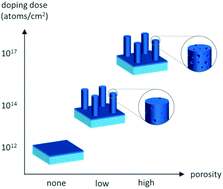Highly doped silicon nanowires by monolayer doping†
Abstract
Controlling the doping concentration of silicon nanostructures is challenging. Here, we investigated three different monolayer doping techniques to obtain silicon nanowires with a high doping dose. These routes were based on conventional monolayer doping, starting from covalently bound dopant-containing molecules, or on monolayer contact doping, in which a source substrate coated with a monolayer of a carborane silane was the dopant source. As a third route, both techniques were combined to retain the benefits of conformal monolayer formation and the use of an external capping layer. These routes were used for doping fragile porous nanowires fabricated by metal-assisted chemical etching. Differences in porosity were used to tune the total doping dose inside the nanowires, as measured by X-ray photoelectron spectroscopy and secondary ion mass spectrometry measurements. The higher the porosity, the higher was the surface available for dopant-containing molecules, which in turn led to a higher doping dose. Slightly porous nanowires could be doped via all three routes, which resulted in highly doped nanowires with (projected areal) doping doses of 1014–1015 boron atoms per cm2 compared to 1012 atoms per cm2 for a non-porous planar sample. Highly porous nanowires were not compatible with the conventional monolayer doping technique, but monolayer contact doping and the combined route resulted for these highly porous nanowires in tremendously high doping doses up to 1017 boron atoms per cm2.



 Please wait while we load your content...
Please wait while we load your content...